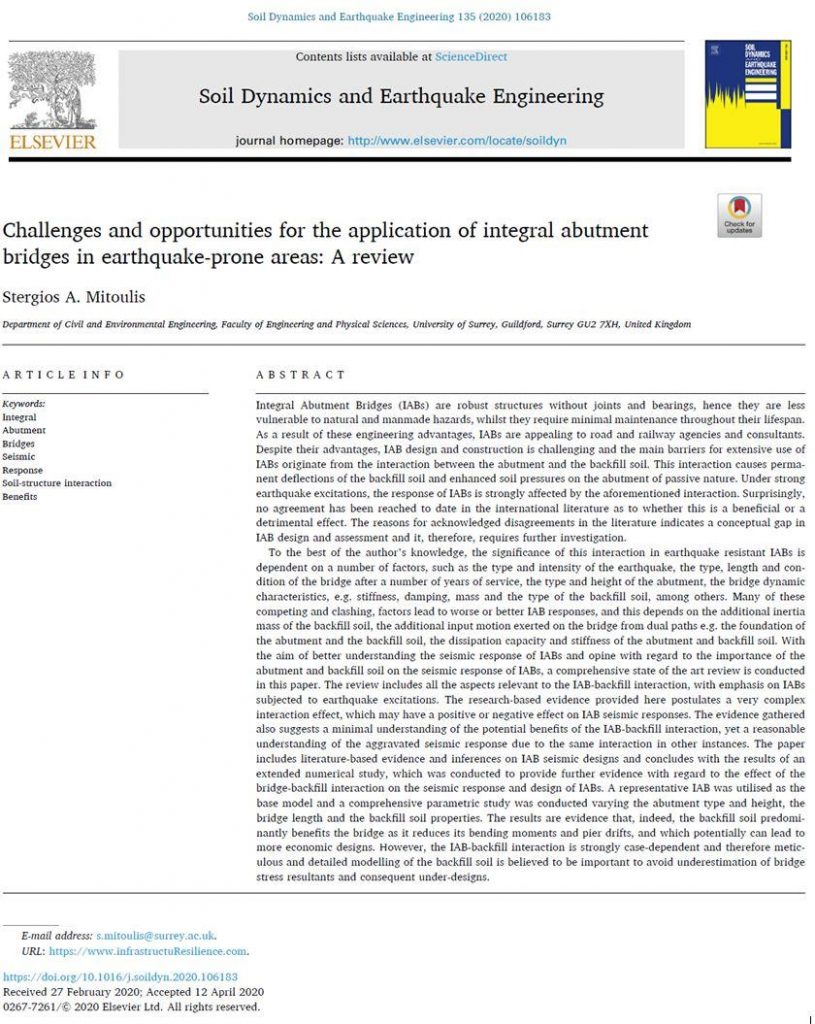Here you will find news relevant to the activities of the initiative including webinars, talks, consulting projects, publications, participation in conferences and meetings mostly relevant to resilience of critical infrastructure with emphasis on transport and energy assets and their intra/interdependencies, views on the UNs Sustainable Development Goals and use of digital and emerging technologies in infrastructure resilience- and sustainability-based management
16
Nov 20
New studentship on the resilience of drinking water supplies in low income countries
Field aspects of the PhD will be undertaken in collaboration with Kyambogo University in Uganda. We are seeking to recruit a PhD student at the University of Surrey. PI: Dr Kathy Pond, Co-PI: Dr Stergios Mitoulis.
The applications have to be made through this link via Reading University
https://research.reading.ac.uk/scenario/apply/
and the project is found here:
https://research.reading.ac.uk/scenario/projects-for-2021-entry/
The PhD project is associated with ongoing research activities being undertaken by the supervisors in East Africa as detailed in King et al., 2020. There is considerable scope for the student to exhibit excellence and originality in developing the details of the project and tailoring the field and desk work to answer novel research questions, which will have real-world impact in both the drinking water and health sector and engineering sector. Incorporating climate change scenarios will also provide an opportunity to explore future challenges to drinking-water infrastructure and the links with UN SDGs. We anticipate that the research from this PhD will be publishable in high impact journals.
26
Sep 20
new paper in the International Journal of Disaster Resilience in the Built Environment
a new paper on “Cost-based resilience assessment of bridges subjected to earthquakes” has been published in the International Journal of Disaster Resilience in the Built Environment, by Sotirios Argyroudis, Giorgos Nasiopoulos, Nikolaos Mantadakis and Stergios Mitoulis.
Transport infrastructure resilience is of paramount importance for societies, therefore its quantification is urgently needed. A resilience assessment framework based on well-informed resilience indices is presented and applied for assessing the resilience of representative bridges exposed to earthquakes.

2
Sep 20
new paper in Transportation Geotechnics
A new paper on “Multiple hazard fragility analysis for granular highway embankments: moisture ingress and scour” has been published in Transportation Geotechnics. This is the result of a collaborative effort between Greg McKeena (ByrneLooby Partners Ltd), Dr Mike G Winter (Winter Associates), Dr Sotirios Argyroudis and Dr Stergios Mitoulis.
The study provides a basis for the prediction of embankment deformation, and hence of damage, due to moisture ingress and scour, which can be aggravated by climate change. This can be used for the assessment of existing assets, and the design of new ones in the pursuit of more resilient transport networks, as well as for other assets such as levees, dams and other similar earthworks, with some limitations. A journal pre-proof is available here
15
Aug 20
new paper in the Science of the Total Environment
our second paper this year in the Science of the Total Engvironment is discussing how resilience of transport infrastructure can be enhanced by deploying digital technologies:
Monitoring of transport infrastructure exposed to multiple hazards: a roadmap for building resilience
by Dimitra V Achillopoulou, Stergios A Mitoulis, Sotirios A Argyroudis and Ying Wang

23
Jul 20
paper on the vulnerability of bearings
Our new paper published in the ASCE Journal of Structural Engineering is on the fragility of bridge elastomeric bearings, on the basis of a novel damage index, and the influence of steel reinforcement plates on their performance.
The paper is co-authored with Dr Kostas Kalfas from Southern Methodist University and Prof Dimitris Konstantinidis, Berkeley University
Read the paper here: https://ascelibrary.org/doi/10.1061/%28ASCE%29ST.1943-541X.0002710

23
Jun 20
Stergios Mitoulis joined the Editorial panel of the Journal: Advances in Civil Engineering of Hindawi
more info about this journal here

1
Jun 20
a monograph published in Soil Dynamics & Earthquake Engineering
Stergios’s recent monograph on Challenges and opportunities for the application of integral abutment bridges in earthquake-prone areas: A review
further info can be found here

1
Jun 20
MDPI editorial panel
Stergios Mitoulis and Sotirios Argyroudis joined the MDPI Editorial panel of the Journal: Sustainability, Editorial panel: Hazards & Sustainability

30
May 20
Stergios authored an Editorial for the Bridge Engineering of the Institution of Civil Engineers (ICE-UK)
Stergios’S Editorial at the Journal of Bridge Engineering of the Institution of Civil Engineers, UK
Proceedings of the Institution of Civil Engineers – Bridge Engineering 173(2): 61–62, https://doi.org/10.1680/jbren.2020.173.2.61

31
Mar 20
Journal paper on monitoring of bridge deflections
Our latest scientific paper on prestressed bridge deflections, has a lot of valuable information for a recent consultancy on the lake Polyfytos Bridge: https://metainfrastructure.org/lake-polyfytos-bridge
Title: Control of long-term deflections of RC beams using reinforcements and low-shrinkage concrete authored by H. Sousa, S. Mitoulis, K. Psarras, I. Tegos. The paper explains how bridge vertical deflections can be alleviated by making use of low shrinkage concrete. The paper can be found here.
